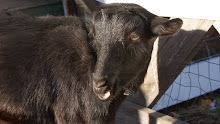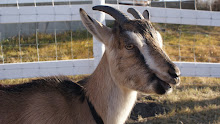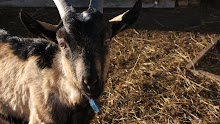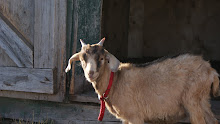It's been just over a month since our chickens all went to their final resting place. Our freezer.
And to be quite honest I'm not really missing the work they created.
I have a good friend who bought a few acres of land down in New Mexico recently and is thinking about raising chickens next year. She's asked for my "expert" chicken advice on a few things, which has made me think about the things I wish I'd known before I jumped in.
Don't get me wrong I did do some research before I order 26 peeping chicks. But considering 26 chickens arrived and 18 Chickens are in the freezer, I'd say there was some learning curve there.
I read a lot of articles in hobby farm type magazines that lead me to believe that raising chickens was so easy pretty much anyone could do it. Shelter. Water. Food. not hard right?
Let me state for the record.
Chickens may be low maintenance for theses sorts of things. But raising them from day old chicks requires a little more finese than the basics.
All the chicks that we lost (8 of them) we lost as chicks. And after the reading and research I've done since I'm kind of surprised we didn't lose more.
So here would be my Top 5 things I wish I'd known before getting Chicks.
(and the things I'd do differently if we raise them again)
1) Temperature is VERY Important- Get a Brooder Thermometer.
Although I had the proper infra red heat lamps for the chicks, and raised or lowered them depending on how the chicks were acting. I've since learned that chicks have no ability to regulate their own body temperature for the first 2 weeks. Therefore~ The brooder house needs to be a consistent 95 degrees for the first week. You can then lower the temperature ( raise the heat lamp) by 5 degree each week until you reach 70 degrees Fahrenheit.
Since I didn't have a thermometer I can't tell you the exact temperature I kept the chicks at. But I can bet between, weather. drafts and water it was not consistent.
2) Have an Adequate Brooder pen
Adequate doesn't have to mean expensive or even bought from a hatchery.The most important aspect to this is a Round chicken pen. Since chicks tend to gather together especially for heat, it's important that they can't squish each other or trap themselves in a corner. Many Hatcheries sell a Brooder guard which is basically just corrugated cardboard that can form about an 8 foot circle.I used my kids old plastic swimming pool and had I made one small modification (drainage holes) it would have worked perfectly. Next year I'll be drilling holes in the bottom of the pool to make sure that there is a way for water to escape instead of collecting in the bottom of the pool, under the straw. Which leads me to...
3) Chicks do NOT like to be WET!
I talked a little bit about my concerns of having wet chicks in a post soon after we got the chicks. I am absolutely convinced that being wet is what killed most of our chicks. We had a combination of a leaky waterer and no drainage. which meant that the chicks stood in (and ultimately played in) water in the bottom of the pool. Unfortunately it was hard to detect the water underneath all the straw until things got really soggy.
4) Seal drafts
Although this may seem obvious. Do everything you can to make sure your barn or chicken coop is protected from the weather outside. I thought getting our Chicks at the end of April would mean that the worst of the winter weather was behind us, and weather wouldn't be a major challenge. BUT. We got Wind. Snow.and Rain within the first few weeks. and the Chicken coop was simply not air tight around doors and windows. Allowing too much fluctuation in temperature. And drafts of cold winds on wet chick. Which inevitably is a bad combination.
5) Have proper waterers -and check them first
Our biggest downfall was having the waterer leaking into the bottom of the pool. The people that use to live here had left a couple of chicken waterers behind. Thinking that I could save some money on equipment, I used them without properly checking to make sure they weren't leaking. This caused the major issues that led to most of the deaths in our coop. If your using hand-me-down equipment, make sure to check it's in proper working condition first. From now on, I'll even be checking new waterers before putting them in a pen. At the end of the day, if a waterer doesn't sit level, or it isn't put together properly, it will leak. Most waterers are designed to stop flowing when they reach a certain level, but this function doesn't work if they are tilted, or have small holes (like ours did in the bottom pan) that lets water escape. and ultimately allows all the water to flow out at once.
I think Honestly, if I had been aware of some of these things, at least some of the chick deaths could have been prevented. If and when I raise chicks again, these are the things I will be doing differently. Some of it may seem like common sense, but I learned these lessons the hard way. By losing chicks that I probably shouldn't have.
The only other thing that I learned was...
Chickens poop a lot and its gross and amazingly sticky.
People will tell you chicken poop smells really, really bad. and it's true. What I didn't know, is that it has to be the stickiest most hard to scrub off substance I have ever seen. Be prepared to spend (lots of) time scrubbing it off of pretty much every surface. We actually had an old snow brush that we used to try and clean all the waterers quicker and easier with the hard bristles (while the brush was long enough that you could keep your hands away from the nasty off spray)
Hey- by no means am I actually a chicken expert. But if sharing my short comings in this little chicken experiment saves anyone the hassle of having to learn these same lessons the hard way...
Friday, November 5, 2010
Subscribe to:
Post Comments (Atom)













Yay! Thank you for the chicken advice. I like the wading pool idea! I think that could work well.
ReplyDelete